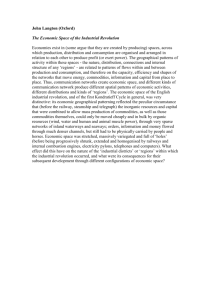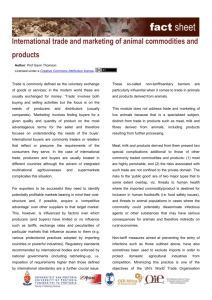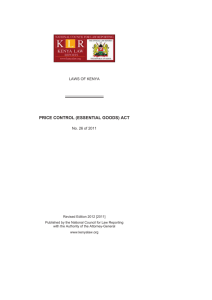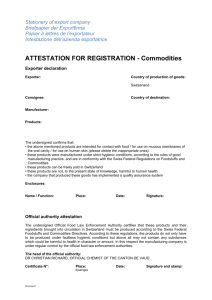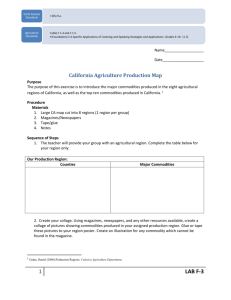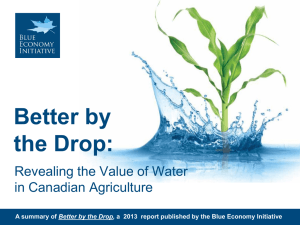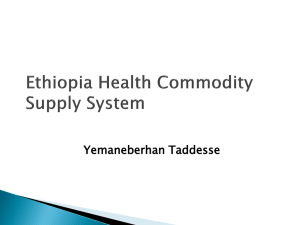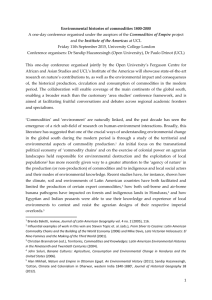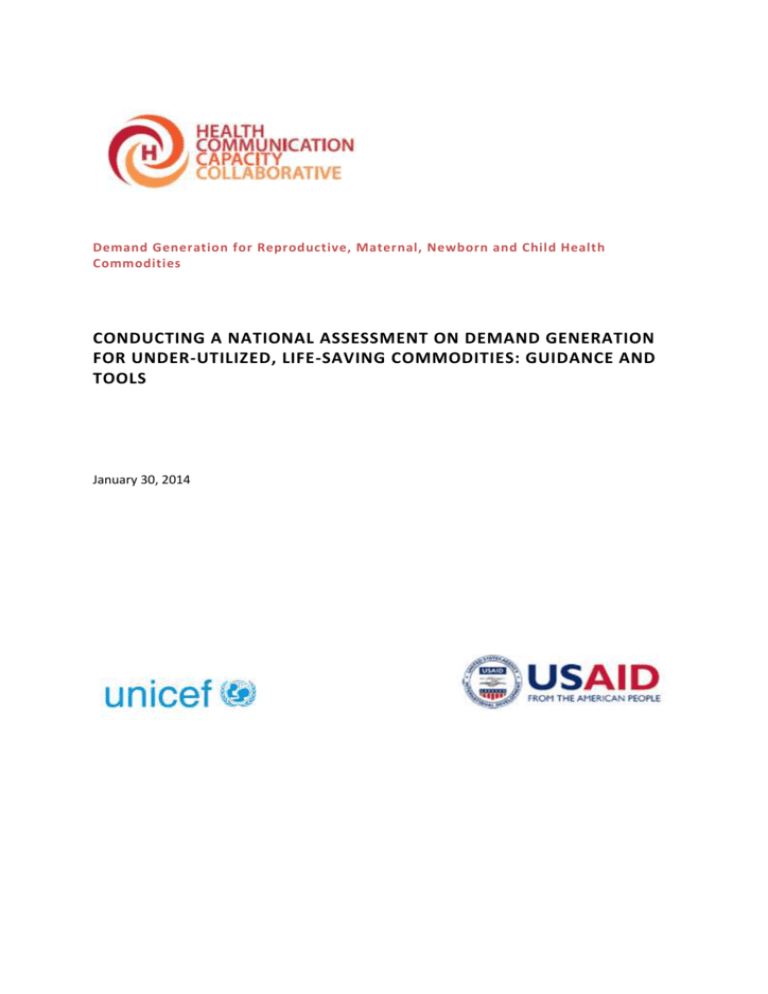
Demand Generation for Reproductive, Maternal, Newborn and Child Health
Commodities
CONDUCTING A NATIONAL ASSESSMENT ON DEMAND GENERATION
FOR UNDER-UTILIZED, LIFE-SAVING COMMODITIES: GUIDANCE AND
TOOLS
January 30, 2014
Acknowledgements
The USAID-funded Health Communication Capacity Collaborative (HC3) – based at the Center for
Communication Programs within the Johns Hopkins Bloomberg School of Public Health – would like
to acknowledge Peter Roberts and Joanna Skinner for authoring this guide with support from Kate
McCracken. HC3 would thanks Kathi Fox, Kim Martin and Mark Beisser for their editing support. HC3
would also like to thank Zarnaz Fouladi, Hope Hempstone and Stephanie Levy at USAID for their
invaluable feedback, guidance and support.
Suggested citation:
The Health Communication Capacity Collaborative HC3. (2014) Conducting a National Assessment on
Demand Generation for Under-Utilized, Life-Saving Commodities: Guidance and Tools. Baltimore:
Johns Hopkins Bloomberg School of Public Health Center for Communication Programs.
The Demand Generation for Reproductive, Maternal, Newborn and Child Health Commodities
activities are implemented by the Health Communication Capacity Collaborative (HC3) at Johns
Hopkins Bloomberg School of Public Health Center for Communication Programs (JHU·CCP), with
support from the RMNCH Trust Fund and the United States Agency for International Development
(USAID), in partnership with Demand Generation Technical Reference Team members, including PSI,
International Consortium on Emergency Contraception (ICEC), Jhpiego and other partners.
©2014, Johns Hopkins University. All rights reserved.
2
Contents
Acronyms ................................................................................................................................................ 4
About this Guide ..................................................................................................................................... 5
Aim ...................................................................................................................................................... 5
Objectives ........................................................................................................................................... 5
Methodology ...................................................................................................................................... 5
Time required ..................................................................................................................................... 5
Outputs ............................................................................................................................................... 6
Structure of the Guide ........................................................................................................................ 6
Key informants.................................................................................................................................... 6
Assessment process overview ............................................................................................................ 6
Dissemination and utilization of findings ........................................................................................... 6
Thirteen Life-Saving Commodities for Women and Children ................................................................. 7
Introduction to Demand Generation ...................................................................................................... 8
Data Collection Modules and Tools ...................................................................................................... 11
Module 1: Desk Review .................................................................................................................... 11
Module 2: Key Informant Interview Tools ........................................................................................ 15
Module 3: National Stakeholder Meeting ........................................................................................ 50
Assessment Outputs ............................................................................................................................. 53
Demand Generation Scorecard ........................................................................................................ 53
Suggested Final Report Outline ........................................................................................................ 55
Sample log of persons interviewed .................................................................................................. 56
3
Acronyms
NEEDS ADDING
4
About this Guide
Aim
This tool provides guidance to country-based partners on how to conduct an in-depth examination
of the demand generation landscape related to country-identified priority commodities for
reproductive, maternal, newborn and child health (RMNCH). It is the first step in laying the
foundations to build strong demand generation programs or strategies. The tool provides guidance
in reviewing existing national evidence on demand generation for priority commodities, identify
major evidence gaps and areas for additional analysis and propose recommendations for the
development of programs to increase demand and utilization of the life-saving commodities.
The assessment is not intended to facilitate primary collection of research data. Where gaps in
current understanding of the drivers of demand are identified, formative research should be
conducted with end-users and their influencing audiences to ensure that program design
addresses the barriers to demand for each specific commodity.
This assessment can complement the broader Rapid Landscape Assessment by the RMNCH Trust
Fund, if carried out, but is not dependent on it.
Objectives
The assessment will synthesize country-specific information to understand:
Policy and systems environment for demand generation in RMNCH;
Social and behavioral barriers and facilitators to uptake and utilization of priority
commodities;
Current tools and approaches used in demand generation programs;
National capacity to carry out demand generation programs;
Current projects related to RMNCH demand generation;
Existing materials aimed at supporting demand generation programs for priority
commodities.
Methodology
The suggested steps to carry out the assessment are as follows:
Step 1) Engage Ministry of Health (MoH) and identify country priority commodities.
Step 2) Adapt data collection tools to country.
Step 3) Conduct desk review to collate existing documentation related to demand for
priority commodities identified by the country and compile into document
inventory.
Step 4) Carry out semi-structured interviews with key stakeholders to verify information
from existing documentation and gather information that may not be available from
existing documentation.
Step 5) Synthesize information gathered and identify key findings.
Step 6) Organize a national stakeholder workshop, including professional associations,
providers (facility, community and private), RMNCH practitioners and researchers to
review the synthesized information and provide expert feedback and review and
reach consensus on key findings.
Step 7) Finalize assessment report.
Time required
Approximately two weeks will be required to compile and synthesize existing documentation, with
another two weeks for the key informant interview verification process.
5
A 3-day workshop culminates the process.
Outputs
1) Completed set of assessment modules;
2) Final report;
3) Inventory and library of relevant documents.
Structure of the Guide
The Guide includes three modules to aid in the assessment process:
Module 1: Desk review
Module 2: Key informant interview tools
Module 3: Stakeholder workshop templates
The final section of the Guide provides suggested outlines for reporting.
Key informants
In Module 2, the most appropriate key informant for a particular tool should be identified. Key
stakeholders include, but are not limited to, the following:
Directors and commissioners in RMNCH Departments of MoH
Officers in Health Education and Promotion Departments of MoH
Donors and partner organizations that support/fund commodities
Technical officers/Social and Behavior Change Communication (SBCC) experts at
international non-governmental organizations (INGOs), local non-governmental
organizations (NGOs) and other partner organizations
Community level implementers of RMNCH or demand generation/SBCC specific programs
Health facility administrators/Managers and health educators
Private sector pharmacists, clinic staff
Assessment process overview
The assessment is designed to follow a logical process. It should start with a comprehensive desk
review of available documentation related to demand generation. Fuelled with that background,
the assessment moves to meeting with the drivers of RMNCH in the country - Senior MoH Directors to provide background on the environmental and policy context in which demand generation
activities are carried out. From there, the assessment attempts to gather information from key
informants to provide depth and up-to-date information on the data gathered through the desk
review about the individual and social determinants of demand generation for the commodities and
the current use of demand generation programming, including process, materials and messages and
evaluation. The assessment then examines the capacity of the lead government agency for SBCC and
SM communication – usually the Health Promotion Unit within the MoH. The assessment records a
full inventory of documents, materials, meetings and individuals involved in the process.
The assessment concludes with a stakeholder workshop to review key findings, reach consensus on
the assessment outcomes and identify opportunities to sharpen current country plans or programs
around demand generation for the prioritized commodities.
Dissemination and utilization of findings
The findings from the assessment should be used to design demand generation programs, either
new or integrated into existing programming, that are based on an evidence-based understanding of
the barriers and facilitators to demand among providers and clients for the under-utilized
commodities. The gaps in existing knowledge on the social and behavioral drivers of demand should
be used to identify areas for formative research prior to designing demand generation campaigns.
6
Thirteen Life-Saving Commodities for Women and Children
In 2010, the United Nations (UN) Secretary-General’s Global Strategy for Women’s and Children’s
Health highlighted the impact that a lack of access to life-saving commodities has on the health of
women and children around the world. The Global Strategy called on the global community to save
16 million lives by 2015 through increasing access to and appropriate use of essential medicines,
medical devices and health supplies that effectively address leading avoidable causes of death
during pregnancy, childbirth and childhood. Under the Every Woman, Every Child (EWEC) movement
and in support of the Global
Strategy and the Millennium
Development Goals (MDGs) 4
and 5, the UN Commission on
Life Saving Commodities
(UNCoLSC) for Women and
Children’s Health was formed
in 2012 to catalyze and
accelerate reduction in
mortality rates of both
women and children. The
Commission identified 13
overlooked life-saving
commodities across the
RMNCH ‘Continuum of Care’
that, if more widely accessed
and properly used, could save
the lives of more than 6
million1 women and children
(Figure 1). For additional
background information on
the Commission please refer
to:
http://www.everywomanever
ychild.org/resources/uncommission-on-life-savingcommodities
Figure 1: 13 overlooked life-saving commodities
1
For assumptions used to estimate lives saved see UNCoLSC Commissioner’s Report Annex
(http://www.everywomaneverychild.org/images/UN_Commission_Report_September_2012_Final.pdf)
7
Introduction to Demand Generation
What is Demand Generation?
Demand generation increases awareness of and demand for health products or services among a
particular intended audience through social and behavior change communication (SBCC) and social
marketing techniques. Demand generation can occur in three ways:
Creating new users - convincing members of the intended audience to adopt new
behaviors, products or services;
Increasing demand among existing users - convincing current users to increase or sustain the
practice of the promoted behavior and/or to increase or sustain the use of promoted
products and services;
Taking market share from competing behaviors (e.g. convincing caregivers to seek health
care immediately, instead of not seeking care until their health situation has severely
deteriorated or has been compromised) and products or services (e.g. convincing caregivers
to use oral rehydration solution (ORS) and zinc instead of other anti-diarrhea medicines).
Demand generation programs, when well-designed and implemented, can help countries reach the
goal of increased utilization of the commodities by:
Creating informed and voluntary demand for health commodities and services;
Helping health care providers and clients interact with each other in an effective manner;
Shifting social and cultural norms that can influence individual and collective behavior
related to commodity uptake; and/or
Encouraging correct and appropriate use of commodities by individuals and service
providers alike.
In order to be most effective, demand generation efforts should be matched with efforts to improve
logistics and expand services, increase access to commodities, and train and equip providers in order
to meet increased demand for products and/or services. Without these simultaneous
improvements, the intended audience may become discouraged and demand could then decrease.
Therefore, it is highly advised to coordinate and collaborate with appropriate partners when forming
demand generation communication strategies and programs.
Who are the Audiences of Demand Generation Programs for the 13 Life Saving
Commodities?
Reducing maternal and child morbidity and mortality through increased demand for and use of
RMNCH commodities depends on the collaboration of households, communities, and societies,
including mothers, fathers and other family members, community and facility-based health workers,
leaders, and policy makers. Some of the commodities are more provider-focused in terms of
demand and utilization, but all depend on care-seeking by women and families.
8
Provider-focused
Provider and end -user
Oxytocin
Female condoms
Magnesium sulfate
Implants
Injectable antibiotics
Emergency contraception
Antenatal corticosteroids
Misoprostol
Resuscitation equipment
Chlorhexidine
Amoxicllin
ORS
Zinc
Care-seeking by women and families
Figure 2: Audiences of demand generation programs
Key Concepts and Definitions in Demand Generation
Social and Behavior Change Communication (SBCC). SBCC promotes and facilitates behavior change
and supports broader social change for the purpose of improving health outcomes. SBCC is guided
by a comprehensive ecological theory that incorporates both individual level change and change at
the family, community, environmental and structural levels. A strategic SBCC approach follows a
systematic process to analyze a problem in order to define key barriers and motivators to change,
and design and implement a comprehensive set of interventions to support and encourage positive
behaviors. A communication strategy provides the guiding design for SBCC campaigns and
interventions, ensuring communication objectives are set, intended audiences are identified, and
consistent messages are determined for all materials and activities.
Social Marketing. Social Marketing seeks to develop and integrate marketing concepts (product,
price, place, and promotion) with other approaches to influence behaviors that benefit individuals
and communities for the greater social good.
(http://socialmarketing.blogs.com/r_craiig_lefebvres_social/2013/10/a-consensus-definition-ofsocial-marketing.html)
Channels and approaches:
Advocacy. Advocacy processes operate at the political, social, and individual levels and work
to mobilize resources and political and social commitment for social and/or policy change.
Advocacy aims to create an enabling environment to encourage equitable resource
allocation and to remove barriers to policy implementation.
Community Mobilization. Community mobilization is a capacity-building process through
which individuals, groups, or organizations design, conduct and evaluate activities on a
participatory and sustained basis. Successful community mobilization works to solve
problems at the community level by increasing the ability of communities to successfully
9
identify and address its needs.
Entertainment Education. Entertainment education is a research-based communication
process or strategy of deliberately designing and implementing entertaining educational
programs that capture audience attention in order to increase knowledge about a social
issue, create favorable attitudes, shift social norms, and change behavior.
Information and Communication Technologies (ICTs). ICTs refer to electronic and digital
technologies that enable communication and promote the interactive exchange of
information. ICTs are a type of medium, which include mobile and smart phones, short
message service (SMS), and social media such as Facebook and Twitter.
Interpersonal Communication (IPC). IPC is based on one-to-one communication, including,
for example, parent-child communication, peer-to-peer communication, counselor-client
communication or communication with a community or religious leader.
Mass and Traditional Media. Mass media reaches audiences through radio, television, and
newspaper formats. Traditional media is usually implemented within community settings
and includes drama, puppet shows, music and dance. Media campaigns that follow the
principles of effective campaign design and are well executed can have a significant effect on
health knowledge, beliefs, attitudes, and behaviors.
10
Data Collection Modules and Tools
MODULE 1: DESK REVIEW
Tool A: Literature collection and synthesis
Purpose:
Collection and analysis of all possible relevant documents, government and NGO project reports,
peer reviewed articles and grey literature addressing demand for the priority commodities. This
includes policies, protocols, guidelines and standards of practice; training materials and clientfocused materials; SBCC and SM efforts to increase demand for the commodities; and any
qualitative or quantitative reports on behavioral outcomes.
Some of these materials – particularly the policies, protocols and guidelines – may have already
been collected as part of the RMNCH Trust Fund Rapid Landscape Assessment (conducted in
some countries).
The desk review of relevant documentation should precede the rounds of interviews and should
pull together as many of the listed documents in the Tool as possible. Further documentation can
be requested during the interviewing process.
Suggested documents to collect
Documents Needed
RMNCH Trust Fund Landscape
Assessment Matrix
Country Health Sector Strategic
Plans
Specific RMNCH-related
Strategies, Roadmaps, Policies,
Protocols and Guidelines
Situation analyses of maternal and
child health issues: National- and
district-level if available
Latest Demographic and Health
Surveys (DHS) and supporting
analytical reports
Country RMNCH Indicators and
Health Management Information
Systems (HMIS) tools and
guidelines
National Demand Creation
Guidelines for RMNCH issues
All related client materials from
public and private sources
RMNCH Project reports, strategy
documents, manuals and client
Likely Sources
RMNCH Trust Fund
Documents Collected
MoH
MoH RMNCH
MoH RMNCH;
Donors, INGOs and
NGOs working on
RMNCH; academics
MoH / Online DHS
website
MoH RMNCH
MoH RMNCH
MoH RMNCH, Health
Education Unit (HEU),
private sector, INGOs
HEU, private sector,
INGOs
11
materials, including print, radio
and TV scripts where possible
Creative briefs used in the
development of RMNCH
campaigns by all key partners
Evaluation reports and peer
reviewed articles about RMNCH
and particularly LSCs in country
INGOs, HEU, private
sector
MoH, HEU, INGOs,
private sector,
scholar.google.com
Rec 7 evidence review
Key Questions for Desk Review
Social and behavioral determinants of demand
Has formative research been conducted among key audiences for each commodity? By
whom? When?
Who are the key audiences for each of the priority commodities?
What are the knowledge, attitudes and behaviors of key audiences related to each priority
commodity?
What are the key barriers and facilitators to demand and utilization? Consider each level of
the social ecological framework, including individual (knowledge, attitudes), interpersonal
(family relationships, provider attitudes), community (norms, access to services) and social
and structural (supply, stock-outs, financial).
Demand generation policies, interventions and activities
What policies facilitate or hinder demand for the commodities?
What commodities are dispensed at facility level? At community level?
What demand generation programs have been implemented for each priority commodity?
What activities/communication channels were used? (e.g., group talks at clinics, house-tohouse outreach, community events, print materials, radio, TV, etc.)
Who were the target audience(s)?
Who were the key partners?
Where were these interventions implemented?
When were these interventions implemented?
Which social and behavioral determinants did they address? Which did they not address?
Were they evaluated? What outcomes were achieved?
12
Tool B: Readability test for electronic print materials for clients and providers
Purpose:
To assess the readability of any materials for clients and providers, which is an important and often
ignored factor in helping people to easily understand health information. There are a number of very
easy and accessible tools to measure readability of electronic text.
Most materials for clients should read between Grade level 4 - 6 at the highest. For providers, that
Grade level could be slightly higher. No materials should be written above Grade 8 for any audience.
Instructions:
1. Select a sample of print materials designed for providers and clients from among those collected
throughout the assessment.
2. Run one or more of the available readability tests described below.
3. Note the results against each of the materials in the table provided.
Readability tests:
Option 1: Microsoft Word (if material available in Word format or can quickly be typed into Word)
1. Open document in Word (or copy text into Word)
2. Click on TOOLS, then on SPELLING AND GRAMMAR
3. Click on OPTIONS
4. TICK the box that says: Show Readability Status
5. Run the GRAMMAR check on your text. You can use IGNORE ALL to speed it up.
6. At the end of the process, the program will give you the scores.
The Flesch Reading Ease is given as a percentage; the higher the percentage, the easier it is to read.
Scores of 0-30 indicates the text is best understood by university graduates.
The Flesch-Kincaid Grade is given on a scale of 1-12; the score represents the US grade level required
to understand the text.
Option 2: Web-based test
1. Go to http://www.readabilityformulas.com/free-readability-formula-tests.php
2. Cut and paste your text into the provided box. Text must be 150-600 words only.
3. Underneath the text insertion window is a security check: Are you a Human? Tick yes.
4. Scroll down the page to view the results.
13
Record results in the following table:
Type of material
Flesch Reading
Ease
Flesch-Kincaid
Grade level score
Free web test
site
Comments
14
MODULE 2: KEY INFORMANT INTERVIEW TOOLS
TOOL C: Interview guide for Directors and Commissioners In RMNCH departments
Purpose:
To obtain an overview of the policy and enabling environment within the country. This information provides the context within which demand creation
programs must function and may speak to the need for structural interventions, as well as SBCC/SM interventions to improve access to and use of the
commodities.
Intended respondents:
RMNCH department directors and commissioners
Introduction
Introduce yourself and other members of the team, including their titles and positions. Present the objectives of the assessment and describe briefly how
the interview with this particular respondent will help the team achieve the objectives. The overall objective of the assessment is to analyse the programs
and interventions that focus on increasing demand for life-saving commodities including (list priority commodities).
Date: ……………………………………………….. Location of interview: ……………………………………………..
Starting time for interview: ……………………………………. Ending time: ……………………………………..
Respondent information
Name: ……………………………………………………. Title/Position at job: …………………………………………
Length of time in that position: ………………………………………………………………………………………………
15
A. REGULATORY AND POLICY ENVIRONMENT
1
What government policies are in
place that address matters related
to RMNCH?
What timeframe do they cover?
(e.g., National health promotion
policy, national health strategic
framework, national RMNCH
policies, international protocols
nationally adopted).
2
(Request copies of those not
collected in desk review)
Do any of these policies
specifically include any of the
priority commodities? Describe.
3
How do these policies facilitate
demand for the priority
commodities?
4
How do these policies hinder
demand for the priority
16
commodities?
6
Are there national counseling
guidelines for providers related to
the commodities? Describe.
7
What training mechanisms are in
place to train providers on
implementing these guidelines?
8
Are any policies or guidelines
currently being developed or
revised that relate to the priority
commodities? Describe.
9
B. PARTNERS, MECHANISMS AND STRUCTURES
What government departments
play a role in generating demand
for the commodities?
10 What other national partners play
a role in generating demand for
17
the commodities?
11
Which of the following are in place and active? Who are members? What are their terms of reference?
Active
(a)
Not
Active
Membership/composition
Specific tasks/terms of reference
RMNCH Technical
Working Group (TWG)?
(b) Coordination
committees across
Departments?
(c)
Others (specify details),
e.g.,
UN Theme groups;
donor groups;
C. RMNCH programs
12
What RMNCH programs are currently active?
Program
Where was
What
What was the program
Did the program
Was the
Who were the partner
18
name
the program
implemented?
13
What challenges and barriers
have there been in implementing
these programs?
14
How consistent is messaging
across all projects on RMNCH
programs?
commodities
are
specifically
included?
approach used? (e.g.,
Guideline development,
provider training, facilitybased services,
community-based, ICT,
etc.). Describe.
include demand
generation? Describe.
program
evaluated?
(Request
report )
organizations?
19
15
Have programs integrated across
reproductive, maternal, neonatal
and child health areas? Describe.
20
TOOL D: Interview guide for donors and partner organizations that support/fund commodities
Purpose:
To explore the policies, interests and actions of country-level actors in RMNCH and identify demand generation programs.
Intended respondents:
RMNCH technical officers
SBCC/social marketing technical officers
Introduction
Introduce yourself and other members of the team, including title and position. Present the objectives of the assessment and describe briefly how the
interview with this particular respondent will help the team achieve the objectives. The overall objective of the assessment is to analyse the programs and
interventions that focus on increasing demand for life-saving commodities including (list priority commodities).
Date: ……………………………………………….. Location of interview: ……………………………………………..
Starting time for interview: ……………………………………. Ending time: ……………………………………..
Respondent information
Name: ……………………………………………………. Title/Position at job: …………………………………………
Length of time in that position: ………………………………………………………………………………………………
21
A. AGENCY SUPPORT/SUPPLY OF COMMODITIES
B.1 1
Does the agency have a strategy
1
related to…? Please describe.
(Request copy)
Has the agency supported
programming related to…? If yes, what
was the approach (e.g., training,
service-delivery, supply, etc.)?
What resource commitments (past
and planned) has your agency
made towards …
NH
MH
Oxytocin
Misoprostol
Magnesium
sulphate
Injectable
antibiotics
Antenatal
corticosteroids
(ANCs)
Chlorhexidine
RH
CH
Resuscitation
equipment
Amoxicillin
Oral
rehydration
salts (ORS)
Zinc
Female
condoms
Contraceptive
22
implants
Emergency
contraception
Were these
programs
evaluated?
(Request reports)
What challenges were
faced in implementation
and/or evaluation?
Is the agency planning to
support any demand
generation programs for…?
Please describe.
Misoprostol
Magnesium
sulphate
Injectable
antibiotics
Antenatal
corticosteroids
(ANCs)
Chlorhexidine
Resuscitation
equipment
Amoxicillin
C
H
NH
MH
C. SUPPORT TO DEMAND GENERATION OF COMMODITIES
D.2
Has the agency
Who were the
supported demand
implementing
generation programs partners?
for…? (Request
sample
materials/documenta
tion)
Oxytocin
23
RH
Oral
rehydration
salts (ORS)
Zinc
Female
condoms
Contraceptive
implants
Emergency
contraception
24
TOOL E: Interview guide for MOH Health Education Unit, SBCC/SM INGOs and NGOs
Purpose:
To identify demand generation interventions for the priority commodities, including all key messages, target audiences, approaches used, etc. It also
gathers information about the process used to design, produce, implement and evaluate demand generation interventions related to the commodities. The
results will provide a picture of how comprehensive and clearly thought out the interventions were and, if there are any written evaluations of the
interventions or campaigns, their impact. This tool also examines human resource capacity.
Intended respondents:
Head, Health Education and Promotion
Senior Health Educators (RMNCH departments)
SBCC/social marketing Technical Advisors in INGOs/NGOs
Introduction
Introduce yourself and other members of the team, including their titles and positions. Present the objectives of the assessment and describe briefly how
the interview with this particular respondent will help the team achieve the objectives. The overall objective of the assessment is to analyse the programs
and interventions that focus on increasing demand for life-saving commodities including (list priority commodities).
Date: ……………………………………………….. Location of interview: ……………………………………………..
Starting time for interview: ……………………………………. Ending time: ……………………………………..
Respondent information
Name: ……………………………………………………. Title/Position at job: …………………………………………
Length of time in that position: ………………………………………………………………………………………………
25
A. COMMUNICATION STRATEGIES FOR LSCs
1. Does the HEU/organization have a stand-alone or integrated communication strategy regarding these life-saving commodities?
Communication
strategy available?
Key content?
How is the strategy being
implemented?
When was the strategy
developed?
MH
Oxytocin
Misoprostol
Magnesium sulphate
NH
Injectable antibiotics
Antenatal Corticosteroids
(ANCS)
Chlorhexidine
Resuscitation equipment
CH
Amoxicillin
Oral rehydration salts (ORS)
Zinc
RH
Female condoms
Contraceptive implants
Emergency contraception
26
Has the HEU/organization developed any demand generation campaigns (such as SBCC or SM) related to these commodities? What are the
approaches, target audiences and partner organizations? (Request any materials related to the campaign)
Campaign
District(s)
Commodity Approach (SBCC, social marketing, Target
Evaluated?
Partner
name
implemented specifically service-delivery, community, ICT,
audience
(Request
organizations
included?
etc.). Please describe key
report)
activities.
Oxytocin
Misoprostol
Magnesium
sulphate
Injectable
antibiotics
Antenatal
Corticosteroids
(ANCs)
Chlorhexidine
Resuscitation
equipment
Amoxicillin
C
H
NH
2
MH
B. DEMAND CREATION INTERVENTIONS FOR RMNCH LIFE SAVING COMMODITIES
27
RH
Oral
rehydration
salts (ORS)
Zinc
Female
condoms
Contraceptive
implants
Emergency
contraception
3
What challenges and
barriers have there
been in
implementing these
campaigns?
4
How consistent is
messaging across all
projects on RMNCH
campaigns?
28
C. ASSESSMENT OF PROGRAMMING
For each campaign, rank the following elements on a scale of 1-5.
1= EXTREMELY POOR
2= POOR
3= ADEQUATE
4= GOOD
5= EXCELLENT
CAMPAIGN
COMPONENT
OVERALL
RADIO
TELEVISION
ASSESSMENT CRITERIA
CAMPAIGN:
CAMPAIGN:
CAMPAIGN:
Branding
Logo
Messaging
Call to action
Integration (with other health
areas/sectors)
Emotional content
Factual information
Level of engagement
Feedback mechanisms
Responsiveness to feedback
Emotional content
Factual information
Level of engagement
Feedback mechanisms
Responsiveness to feedback
29
PRINT
COMMUNITY
ACTIVITIES
ICT & NEW
MEDIA
Emotional content
Factual information
Level of engagement
Feedback mechanisms
Responsiveness to feedback
Emotional content
Factual information
Level of engagement
Feedback mechanisms
Responsiveness to feedback
Emotional content
Factual information
Level of engagement
Feedback mechanisms
Responsiveness to feedback
D. CAMPAIGN DEVELOPMENT PROCESS
5
Does the HEU/organization develop work
plans for its SBCC programs? Please
describe. (Request samples)
6
Does the HEU/organization rely on
research data to assist with the design of
SBCC programs? Please describe.
7
Does the HEU/organization conduct
situational analysis before designing SBCC
programs or ensure that partners do so?
Please describe the typical process taken.
30
8
For any of the campaigns mentioned, was
there a theoretical framework used to
inform the design and implementation?
Please describe.
9
How does the HEU/organization develop
content for demand generation activities,
materials and messages? (Description of
steps that are involved)
Does the HEU/organization develop M&E
plans for its SBCC programs? (Request
sample)
10
11
What challenges does the
HEU/organization face in implementing
M&E plans?
12
Does the HEU/organization evaluate the
impact of demand generation programs?
(Request sample evaluation report)
13
Does the HEU/organization coordinate
implementation of SBCC programs among
partners (e.g., MoH departments, INGOs,
NGOs and civil society groups)? Please
describe.
14
What challenges does the
HEU/organization face in coordination with
31
partners?
15
16
What support is required to improve
coordination?
E. MESSAGE AND MATERIALS DEVELOPMENT
Has the HEU/organization developed any materials to create demand for the commodities? (Request copies and use to verify content)
Type of
material
(e.g.,
brochure,
poster,
SMS, etc.)
Year
Key messages
developed
Target audience
Reviewed by technical
experts?
Pretested among target
audience?
NH
MH
Oxytocin
Misoprostol
Magnesium
sulphate
Injectable
antibiotics
Antenatal
Corticosteroid
(ANCS)
32
Chlorhexidine
RH
CH
Resuscitation
equipment
Amoxicillin
Oral
rehydration
salts (ORS)
Zinc
Female
condoms
Contraceptive
implants
Emergency
contraception
F. HUMAN RESOURCE CAPACITY
17
18
19
Describe the capacity of
HEU/organization staff to
manage and implement
demand generation programs.
Describe the capacity of
HEU/organization staff to
monitor and evaluate demand
generation programs.
Does the HEU/organization
have a plan for regularly
33
20
21
22
strengthening staff
competencies in SBCC/SM?
Please describe.
When was the last SBCC
training received, and what
was the focus of that training?
What capacity strengthening
does the HEU/organization
need for improved and
effective demand creation for
these commodities?
What sources of information
do staff use to keep up-to-date
on SBCC/SM issues? Prompt
for specific sources.
23
What web-based tools and
learning opportunities do staff
use to build capacity in
SBCC/SM?
24
What barriers do staff face in
using web-based tools and
training?
34
35
Tool F: Interview guide for community level implementers of RMNCH and/or DG programs
Purpose:
To collect existing information on community and provider levels (key audiences) of knowledge, attitudes and practice surrounding each commodity.
Intended respondents:
Community level implementers of RMNCH programs
Community level implementers of demand generation/SBCC programs
Introduction
Introduce yourself and other members of the team, including title and position. Present the objectives of the assessment and describe briefly how the
interview with this particular respondent will help the team achieve the objectives. The overall objective of the assessment is to analyse the programs and
interventions that focus on increasing demand for life-saving commodities including (list priority commodities).
Date: ……………………………………………….. Location of interview: ……………………………………………..
Starting time for interview: ……………………………………. Ending time: ……………………………………..
Respondent information
Name: ……………………………………………………. Title/Position at job: …………………………………………
Length of time in that position: ………………………………………………………………………………………………
36
NH
MH
A. COMMUNITY KNOWLEDGE, ATTITUDE AND CURRENT BEHAVIOUR SURROUNDING EACH COMMODITY
1. Based on the organizations own formative research and experience in implementing community level RMNCH and/or demand generation programs, what
is the community knowledge, attitude and behavior surrounding each applicable commodity? What are the key barriers to each commodity?
B. 1
Community knowledge of…
Community attitude towards…
Current community behaviors
Key barriers
1
surrounding…
identified
Oxytocin
Misoprostol
Magnesium
sulphate
Injectable
antibiotics
Antenatal
corticosteroids
(ANCs)
Chlorhexidine
RH
CH
Resuscitation
equipment
Amoxicillin
Oral
rehydration
salts (ORS)
Zinc
Female
condoms
Contraceptive
37
implants
Emergency
contraception
NH
MH
B. PROVIDER KNOWLEDGE, ATTITUDE AND CURRENT BEHAVIOUR SURROUNDING EACH COMMODITY
2. Based on the organizations own formative research and experience in implementing community level RMNCH and/or demand generation programs, what
is the community PROVIDER (clinical and non-clinical) knowledge, attitude and behavior surrounding each applicable commodity? What are the key barriers
to each commodity?
C. 1
Provider knowledge of…
Provider attitude towards…
Current provider behaviors
Key barriers
1
surrounding…
identified
Oxytocin
Misoprostol
Magnesium
sulphate
Injectable
antibiotics
Antenatal
corticosteroids
(ANCs)
Chlorhexidine
CH
Resuscitation
equipment
Amoxicillin
Oral
rehydration
salts (ORS)
38
RH
Zinc
Female
condoms
Contraceptive
implants
Emergency
contraception
NH
MH
C. CURRENT PROGRAMMING (Key Messages, Channels/Medium, Successes, Challenges)
3. Based on the organizations current community level RMNCH and/or demand generation program, what are their key messages and channels/medium used
to get the messages to their target audiences? What types of measureable successes has the organization experienced in their RMNCH or DG program? What
are/were their challenges to implementation, uptake, monitoring, etc?
D. 1
Key Messages
Channels/Medium
Successes
Challenges
1
Oxytocin
Misoprostol
Magnesium
sulphate
Injectable
antibiotics
Antenatal
corticosteroids
(ANCs)
Chlorhexidine
Resuscitation
equipment
39
Oral
rehydration
salts (ORS)
Zinc
RH
CH
Amoxicillin
Female
condoms
Contraceptive
implants
Emergency
contraception
D:
ADDITIONAL LESSONS LEARNED & RECOMMENDATIONS
4. Are there any additional lessons or recommendations that the organization would like to share?
40
TOOL G: Interview guide for health facility staff
Purpose:
To explore the policies, interests and actions of country-level actors in RMNCH and identify demand generation programs.
Intended respondents:
Administrators/managers of facilities
Health educators at facilities
Introduction
Introduce yourself and other members of the team, including title and position. Present the objectives of the assessment and describe briefly how the
interview with this particular respondent will help the team achieve the objectives. The overall objective of the assessment is to analyse the programs and
interventions that focus on increasing demand for life-saving commodities including (list priority commodities).
Date: ……………………………………………….. Location of interview: ……………………………………………..
Starting time for interview: ……………………………………. Ending time: ……………………………………..
Respondent information
Name: ……………………………………………………. Title/Position at job: …………………………………………
Length of time in that position: ………………………………………………………………………………………………
41
TYPE OF FACILITY
1
What is the facility ownership?
(circle)
2
3
4
5
What is the level of unit?
(e.g., Regional hospital, district
hospital, health center, pharmacy,
shop)
Where is the facility located?
(circle)
How many staff work at this
facility? (circle)
Private
Social franchise
Public
Urban
Peri-urban
Rural
1-5
6-10
11-15
16-20
21+
Which of the following commodities are
promoted within the facility? (Read list &
circle)
(a)
(b)
(c)
(d)
(e)
(f)
(g)
(h)
(i)
(j)
(k)
(l)
Oxytocin
Misoprostol
Magnesium sulphate
Injectable antibiotics
Antenatal corticosteroids (ANCs)
Chlorhexidine
Resuscitation equipment
Amoxicillin
Oral rehydration salts (ORS)
Zinc
Female condoms
Implants for contraception
42
(m) Emergency contraceptives
6
Does the facility maintain an adequate
supply of these commodities? Why/why
not?
7
Do staff in this facility have sufficient
knowledge and understanding of these
commodities? Describe.
8
What kind of support and training have
staff received to increase knowledge and
understanding of these commodities?
Describe.
9
Does the facility use national counseling
guidelines (if available) related to the
commodities? Describe.
10
What training mechanisms are in place to
43
train providers on implementing these
guidelines?
11
Do clients come here to seek out these
commodities? If not, why not?
CLIENT MATERIALS
12
What materials are available within the health unit to increase demand among clients? (Request copies)
TYPE OF MATERIALS (e.g.,
flipchart, leaflet, poster,
brochure, 3D demo model, client
cards, etc.)
What are the key messages?
Are these materials
routinely used by staff
in this facility?
MH
Oxytocin
Misoprostol
Magnesium sulphate
NH
Injectable antibiotics
Antenatal
corticosteroids (ANCs)
44
Chlorhexidine
CH
Resuscitation
equipment
Amoxicillin
Oral rehydration salts
(ORS)
Zinc
RH
Female condoms
Contraceptive
implants
Emergency
contraception
13
What client materials would be useful that
are not currently available at the facility?
45
INSTRUCTIONS TO INTERVIEWER: FOR EACH CLIENT MATERIAL, RANK FOR THE FOLLOWING CRITERIA ON A SCALE OF 1-5
COMPLETE SHEET FOR EACH COMMODITY WITH MATERIALS AVAILABLE
1= EXTREMELY POOR
2= POOR
3= ADEQUATE
4= GOOD
5= EXCELLENT
Commodity: ___________________
11
MATERIAL:
a
Clarity of information
b
Usefulness/Responsiveness
to needs of clients
Reliability
c
d
e
MATERIAL:
MATERIAL:
MATERIAL:
MATERIAL:
Breadth of information and
range of topics covered
Availability for use
46
TOOL H: Interview guide for private sector distributors
Purpose:
To explore private sector strategies and materials used to generate demand for priority commodities.
Intended respondents:
Marketing managers at distribution companies
Introduction
Introduce yourself and other members of the team, including title and position. Present the objectives of the assessment and describe briefly how the
interview with this particular respondent will help the team achieve the objectives. The overall objective of the assessment is to analyse the programs and
interventions that focus on increasing demand for life-saving commodities including (list priority commodities).
Date: ……………………………………………….. Location of interview: ……………………………………………..
Starting time for interview: ……………………………………. Ending time: ……………………………………..
Respondent information
Name: ……………………………………………………. Title/Position at job: …………………………………………
Length of time in that position: ………………………………………………………………………………………………
Company name: ………………………………………… Company sector: …………………………………………
1
Which of the following commodities does
your company distribute? (Read list &
(a) Oxytocin
(b) Misoprostol
47
circle)
2
Why does the company not distribute [list
those commodities not mentioned]?
3
What marketing strategies does the
company have regarding the commodities
it distributes?
4
What are the key challenges regarding
creation of demand among customers?
5
What marketing materials does the
(c) Magnesium sulphate
(d) Injectable antibiotics
(e) Antenatal corticosteroids (ANCs)
(f) Chlorhexidine
(g) Resuscitation equipment
(h) Amoxicillin
(i) Oral rehydration salts (ORS)
(j) Zinc
(k) Female condoms
(l) Implants for contraception
(m) Emergency contraceptives
48
company use? (Request copies)
6
What medical detailing does the company
conduct? Describe.
49
MODULE 3: NATIONAL STAKEHOLDER MEETING
TOOL H: Sample invitation letter
Increasing Demand for Life Saving Commodities in Reproductive, Maternal, Newborn and
Child Health
National Level Demand Generation Assessment: Stakeholders Meeting
[DATE]
Dear............................................................
[Organization name], together with the Ministry of Health and the [e.g. Maternal and Child Health
Technical Working Group], will organize a national stakeholders meeting on the assessment of
demand for life saving commodities for Reproductive, Maternal, Newborn and Child Health
(RMNCH), from [dates].
As part of the Every Woman Every Child (EWEC) movement, the UN Commission on Life Saving
Commodities (UNCoLSC) for Women and Children’s Health identified 13 overlooked life-saving
commodities across the RMNCH ‘Continuum of Care’ that, if more widely accessed and properly
used, could save the lives of more than 6 million women and children. The Commission identified
low demand of essential life saving products as one of the key barriers to access and use and called
for improving demand for and utilization of health services and products among underserved
populations.
[Organization] is completing an assessment on demand generation activities and capacity in
[country] related to the 13 underutilized commodities in RMNCH. The stakeholders meeting is a
culmination of that assessment and aims to review and debate the findings to date, to examine the
implications for the demand-related activities in [country’s] country plan for RMNCH, and to
introduce new tools and resources that can be used to support those activities.
The agenda for the workshop is attached herewith. As you will note, the first two days will focus on
reviewing the demand assessment findings and developing a way forward to integrate the findings
on life-saving commodities with existing country level RMNCH activities.
Please note this is a full agenda and we hope that you will be able to participate fully throughout the
workshop. The venue for this workshop will be .................................. Kindly confirm your
participation and attendance for this workshop.
We look forward to your attendance and expert contributions.
Sincerely,
[Name]
[Title]
50
TOOL I: Sample agenda
Increasing Demand for Life Saving Commodities in Reproductive, Maternal, Newborn and Child
Health
National Level Demand Generation Assessment Stakeholders Meeting
[DATE] [VENUE]
Day 1: [Date]
Time
Activity
Session 1: OPENING OF THE MEETING
08:30 Arrival and Registration
09:00 Introductions
09:15 Introductory Remarks
09:45 Overview and objectives of the workshop
10:15
Tea Break
Session 2: ASSESSMENT FINDINGS
10:45 Data assessment tools and methodology
11:15 Social and behavioral drivers of demand for the life-saving
commodities
12:00 Discussion - Q & A
13.00
Lunch Break
14:00 Demand generation activities in RMNCH and the life-saving
commodities
14:45 Discussion – Q & A
15:00
Tea Break
15:30 Completion of demand generation scorecard - group work
16:30 Group work presentations and plenary discussion
17.15 CLOSE OF DAY 1
Facilitator /
Presenter
51
Day 2: [Date]
Time
Activity
Session 3: DEMAND CREATION ACTIVITY PLAN
09:00
Reflections on Day 1
09:15
Recommendations for addressing gaps identified in the assessment–
Facilitator / Presenter
Group work
11:00
11.30
12:30
13:30
14:15
15.00
15:30
16.00
16.30
17:00
17:15
Tea Break
Group work presentations
Lunch Break
How assessment and recommendations can help refine demand creation activities
for life-saving commodities and integration with RMNCH activities – group work
Group work presentations
Draft Plan – Moving ahead – Group exercise
Tea Break
Group presentation on draft plan
Action plan for inclusion in the final report
Workshop evaluation (Days 1 & 2)
CLOSE OF DAY 2
52
Assessment Outputs
Demand Generation Scorecard
Instructions: Complete each box in the scorecard with a color as indicated in the scale for performance (high, mid, low) and barriers to demand (high, mid,
low) based on findings of the national assessment. The result provides a quick-glance heat map to assist in identified strong and weak areas in the country’s
overall demand landscape for RMNCH commodities.
53
54
Suggested Final Report Outline
Preliminary pages
Acronyms
List of tables and figures
Acknowledgements
Executive Summary
1. Introduction
1.1
1.2
1.3
1.4
Background and context
Country status of Reproductive, Maternal, Neonatal and Child Health (RMNCH)
Legal and policy environment for RMNCH
Priority life saving commodities identified
2. Assessment Methodology
3. Assessment findings
3.1 Enabling environment and the Government role in health promotion for life-saving commodities
3.2 Country partners working in RMNCH demand generation
3.3 Social and behavioral drivers of demand for the life-saving commodities
3.4 Current/past demand generation activities related to the life-saving commodities
a) Development process
b) Messages and materials
c) Programming quality
d) Readability of materials
3.5 Gaps and challenges in demand generation
3.6 Opportunities for increasing access and demand for essential commodities
4. Technical capacity assessment
4.1 Assessment of capacity to plan for demand generation
4.2 Capacity for implementation and evaluation
4.3 Capacity gaps
5. Conclusions and Recommendations
Appendices
Log of persons interviewed
Inventory of documents reviewed
Assessment tools
55
Sample log of persons interviewed
Person
interviewed
Organization
Position
Contact info
Date
Interviewer
Materials collected (against each
interviewee, where applicable)
Tool A
Tool B
Tool C
Tool D
Tool E
56

